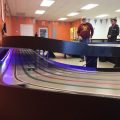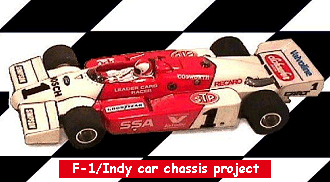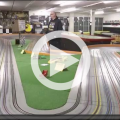All Right, So What is a Slot Car, Anyway???
or
The Question Every Non-Slot Car Racer Who Finds This Site Is Probably Asking
By Jett Guideflagg
![]()
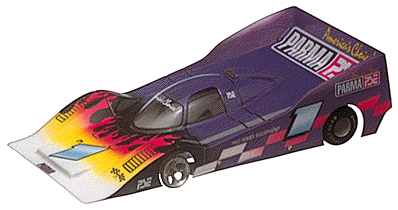
1/24 Scale GTP Car – Photo Courtesy of Parma
If you are discovering the world of slot cars for the very first time here, you are most likely a little bit hazy on just what a slot car is. In my 30+ years in the sport I’ve heard them confused with everything from radio control cars to Hot Wheels, to some sort of coin-operated vehicle. Slot Cars are none of these.
Slot cars are known to some as “that cute little car racing set my older brother had when I was a kid”. They may also be known as “those #@%^*! little cars my (son, husband, boyfriend — pick one) spends all his time and money tinkering with.” Slot cars also cause their owners to be asked, “are you still playing with toy cars at your age?” The answer, of course, is always yes, spoken through a wide grin. Bear in mind, however, the adage that the only difference between men and boys is the price of their toys. Slot cars are big boys toys. They are also little boys toys. And, increasingly, they are the toys of both little girls and grown women.
So, just what is a slot car?
A slot car is miniature racing car that is guided by a blade or pin-shaped device that sticks down from the bottom of the car’s front end and follows a slot in the track surface. The car is powered by a small but very powerful electric motor. The motor draws electricity, usually 12 volts DC, from metal stripes on either side of the slot. The driver controls the car by means of a pistol-shaped speed control. He (or she) gives the car full throttle down the straightaways and tries to power the car through the turns as fast as it will go without coming out of the slot.
The challenges involved in winning are very much like those of racing full-size cars. The car with the most acceleration and top speed on the straights, the best handling in the turns, and the driver who can most consistently drive it to its limits without exceeding them will be the winner.
Slot car racing has the unique aspect of being both a hobby and a sport, combining the hobby of building and tuning the cars with the sport of competitively racing them. Slot cars come in three sizes or “scales”. Within each scale there are several distinct types of cars as well as different levels of competition.

OWH Photo – HO D-Jaguar by Dale Weber
The scale familiar to the greatest number of Americans is HO scale. HO scale slot cars started out as a roadway system for HO (1/87 scale) model trains. It did not take long for people to discover that the cars could be raced, and in many basements the cars took over from the trains. Modern HO cars are anywhere from 1/64 to about 1/70 scale and are about two inches long. HO racing sets, with cars, controllers, power supply, and accessories, sell by the hundreds of thousands every Christmas in stores of many kinds. They are popular because of their small size and low price. An HO race set can be bought for as little as $40 on sale, and an elaborate layout can be set up in a space as small as 4′ X 8′.
HO cars are extremely fast for their size. They routinely reach scale speeds of 600 miles per hour or more. HO cars have strong magnets in the bottom of the chassis which are attracted to the steel strips in the track. The downward force created by the magnets produces high traction and cornering speeds.
HO racing has the widest range in level of participation. Not only did kids drool over the cool HO sets in the Christmas catalog, but HO cars have also evolved into serious organized racing machines, with modifications from specialized custom parts, to precisely tuned hand built cars. HO’s are raced anywhere from the living room floor, on garage or basement club tracks, to custom built 8-lane commercial raceway tracks. HO cars start in price at around $15, and race sets starting at around $50 or less. The race sets include plastic “snap-together” track sections, cars, controllers, and power supply.
The next most widely raced scale in America is 1/24. These cars are raced primarily on large tracks in commercial raceways, though a few individuals have built home tracks for them or squeezed commercial sized tracks into basements or garages.
There are three main categories of 1/24 scale cars. Two of them use bodies made of extremely thin, light vacuum-formed polycarbonate plastic. These bodies are clear and are painted on the inside. “Scale” cars use bodies that bear at least some identifiable resemblance to full-size race cars. “Scale”, as used here, is a relative term, since the cars’ proportions, overall shape, and details are greatly altered from those of their full-size prototypes. “Wing” cars, however, look nothing like a full-size car. A wing car body is essentially a pure aerodynamic wedge with large spoilers and air dams. Its sole purpose is to produce maximum aerodynamic downforce. What the car looks like is basically irrelevant. The third category of 1/24 slot cars is called “hard-bodies” (No… not the ones flexing muscles at the beach). These cars use plastic model kit bodies, most often of NASCAR Winston Cup cars.
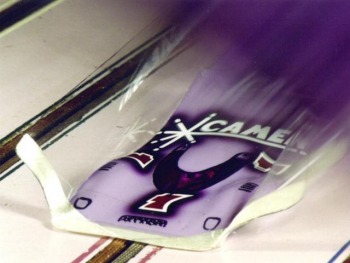
1/24 Scale Group 7 “Wing” Car – Photo Courtesy of Camen
Wing cars, with their high-downforce bodies, ultralight motors and chassis, and incredible power-to-weight ratio, are the fastest of all slot cars. The motors for Group 7 cars are custom designed and hand crafted, and use cobalt magnets, and can cost well over $200 – just for the motor. Group 7 races usually require using several of these motors, changing them between heats of racing, to complete a race. Races consist of eight heats of racing, driving each lane on the track, so as in the top level in many other sports, this can get expensive.
Another aspect of wing car racing, is the use of “glue”, or traction additives. Tire “glue” is a mixture consisting mostly of very heavy oil, with the consistency and stickiness resembling honey. It is applied to the track at the breaking points before the turns, allowing the cars to zip through the turns at uncanny speeds. Some raceways use “spray glue”, thinned down and sprayed on the turns prior to the race, while others allow additives applied only to the tires.
The chassis are extremely light weight design, with the bare minimum amount of lazer or EDM cut steel required to hold together the few components. Open, or Group 7, wing cars are the quickest accelerating wheeled vehicles on the planet, capable of reaching 70 miles per hour in under half a second. You can get whiplash of the eyeballs just trying to watch one of these cars go around the track! In fact, they have achieved lap times around a 155′ “Blue King” track (a popular banked track design found throughout the world), of *under* two seconds!
Wing cars have several classes featuring limited motor and chassis restrictions, offering a range from entry level cars for around $40, up to the Group 7 cars costing several hundred dollars.
“Scale” cars race primarily on flat, or unbanked tracks, and do not utilize spoilers or air dams for air control, or allow traction additives applied to the track. They depend more on weight distribution and flex in chassis design, and require more “finesse” then reflexes to drive, compared to wing cars. They range from stamped steel “Flexi-Car” classes with various motor classes for entry level and intermediate racers, to “Eurosport” cars, featuring extremely light and powerful cobalt-magnet motors very similar to those used in Group 7 wing cars. The chassis are intricately designed, and are made of lazer or EDM cut spring steel, with a lot of emphasis on weight and flex to achieve improved handling.
While 1/24 and HO are the most prominent scales in American slot car racing, 1/32 scale dominates in the rest of the world, and is growing rapidly in popularity in America. 1/32 has traditionally been the club racing scale of choice. It also features the most authentic looking cars.
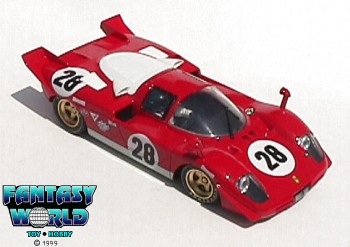
1/32 Scale Fly Ferrari 512S
Photo Courtesy of Fantasy World Toy & Hobby
European manufacturers, notably Scalextric, Ninco, Fly, and SCX, produce 1/32 scale race sets and cars. The cars are highly detailed scale models that are frequently mistaken for quality diecasts. The cars have injection-molded bodies, plastic chassis, solid rubber tires, and motors of quite modest performance. They are designed to go fast enough to be fun to drive and a challenge to race. The race sets, like HO, include plastic “snap-together” track sections, cars, controllers, and power supply. The emphasis is on realism, driving skill, and dependability. Hundreds of different cars are available, and the cars are highly collectible. These cars can be great fun and provide an ideal introduction to the sport. Cars range from $30-$60, and race sets sell for $120 and up.
American manufacturers also produce higher performance 1/32 scale cars with stamped brass or steel chassis, clear Lexan bodies, and much more powerful motors. These cars use many of the same components as entry and intermediate level 1/24 scale cars, and are raced on home and club tracks, and at some commercial raceways. Even faster 1/32 scale cars, using lazer or EDM cut steel chassis and cobalt-magnet motors, approach the performance of high-end “Eurosport” type 1/24 cars and can cost in the hundreds of dollars.
There are several different classes of cars in all scales and categories, with a wide range of body styles, price range, and skill level, allowing a wide variety of classes to compete in. Each scale and class of slot car racing has its own following, and appeals to a different set of interests. Your local hobby shop or slot car raceway can help get you started by showing you different kinds of cars, tracks, and race sets. Look at all the options and pick the one that suits you best. Whichever you choose, you will have fun, learn new skills, meet interesting people, and make new friends while enjoying your new hobby.
Welcome and good racing!!!
![]()
To learn more about slot cars – check out The Old Weird Herald!











